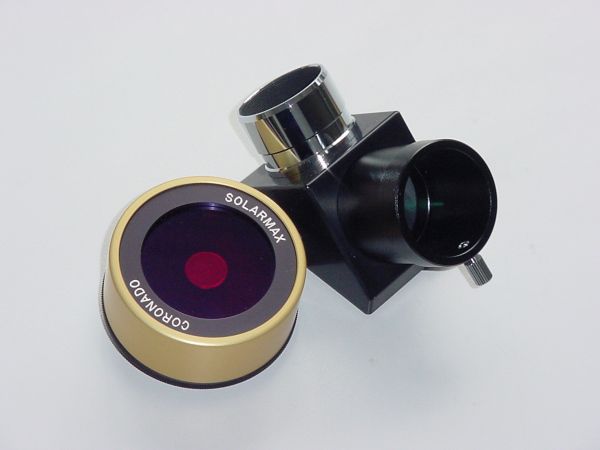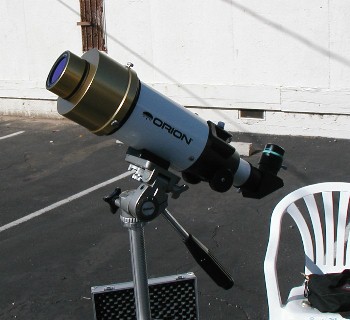Tim's Solar Observing
Page
 For
years, like most amateur astronomers, I have been observing sun spots with
the 'normal' white light solar filter for the telescope. And again, like
most amateur astronomers, I have dreamed of some day owning a Ha (Hydrogen
Alpha) filter to see the solar flares and atmospheric details on the sun.
For
years, like most amateur astronomers, I have been observing sun spots with
the 'normal' white light solar filter for the telescope. And again, like
most amateur astronomers, I have dreamed of some day owning a Ha (Hydrogen
Alpha) filter to see the solar flares and atmospheric details on the sun.
During the 2001 Riverside
Telescope Makers Conference in Big Bear California, Coronado
Instruments from Tucson Arizona was one of the vendors displaying their
equipment. In making my rounds of visiting the various manufacturers, Coronado
was one of those companies that made the Ha filter. During the 3-day event,
I must have visited their booth and gazed at the sun, with huge flares
flying off of it a dozen times. Now during RTMC, my non-astronomer ex-wife,
usually visits the antique shops in town, but one day, she was walking
with me as we passed the Coronado booth. The views were amazing, so i asked
her if she wanted to take a look. She said yes, just to shut me up. One
glance in the eyepiece, and she looked at me and said, "You need one of
these". I laughed, but she said it again. "I could enjoy seeing the sun
like this." Well, that floored me. She then said, "How about I get
it for your birthday" I said, "Honey the thing is about $900." She said,
"then it will be your birthday present". Now thinking quickly, I realized
that it would be overkill to put this filter on my 4.7-inch refractor,
so I pushed the limit. "Honey, baby, sweetie, I will need another telescope
to use with this filter". At that she said, "Okay, that can be your Father's
Day present". At this, the guys at the Coronado booth were smiling,
and I was completely in shock. Then the thought came over me, what the
hell did she buy in town?
Needless to say, I bought Orion ST80 for
Fathers Day, and she ordered the SolarMax.
The SolarMax
(For technical information on how the
SolarMax work, visit the Coronado
Website.)
 The
Solarmax is two basic components. The Etalon Filter and the Blocking diagonal.
The
Solarmax is two basic components. The Etalon Filter and the Blocking diagonal.
The Etalon filter is based on the principle
of the Fabry-Perot interferometer. In general,- two highly reflecting,
non-absorbing, coatings separated by a parallel gap. The front plate of
the Eaton has over 165 layers of coating. Such a structure is referred
to as an 'Eaton.' Etalons are plane parallel plates separated by
a fixed gap. The manufacturing tolerances for efficient operation are extremely
critical and CIG etalons utilize a number of advanced optical and coating
fabrication techniques, specifically developed for etalons, which make
them the finest available.
The Blocking Filter is encased in the diagonal
that is supplied by Coronado. It contains semi-aluminized mirror that only
transmits partial light, and a blocking filter with 86 layers of coating.
The cost of these units is rather high,
but the manufacturing process that must be accomplished is highly critical
and close tolerance. We are talking measurements in light waves here folks!.
Ha Light
The red light of hydrogen alpha with a
wavelength of 656.3 nm (1 nm = 1 billionth of a meter) is a very prominent
feature in the solar light spectrum since hydrogen makes up 75% by weight
of the outer layers of the sun. This light shows us layers up to 1700 km
above the sun's visible surface and is especially important for imaging
the lower chromosphere. The lower chromosphere is the coolest layer in
the sun's atmosphere. The H alpha picture of the sun is very useful in
predicting eruptions. The bright regions around sunspots, called plages,
and brilliant solar flares are easily seen at this wavelength. Filaments,
vivid string-like regions, and sunspots, large blotches on the solar surface,
appear dark. Filaments are common sources of eruptions. Filaments on the
solar limb appear bright against the blackness of space and are called
prominences.
My Solar Observing
Setup
 I
use the Orion ST80 refractor telescope, available from Orion
Telescope and Binocular. This telescope is compact and easy to setup
and use. The night time images through this telescope are very good as
well. For night viewing I attach this telescope on top of my 4.7" refractor.
For solar observing I have the ST80 on a Orion EQ-1 Mount with an electric
drive motor..
I
use the Orion ST80 refractor telescope, available from Orion
Telescope and Binocular. This telescope is compact and easy to setup
and use. The night time images through this telescope are very good as
well. For night viewing I attach this telescope on top of my 4.7" refractor.
For solar observing I have the ST80 on a Orion EQ-1 Mount with an electric
drive motor..
Along with the Etalon and the Blocking
filter, Coronado supplies you with an adapter plate that fits over the
end of the telescope. The adapter plate for the OrionST80 required that
the dew cap be pulled off. It is only press fitted into place on the telescope.
Once you remove the dew cap, then the adapter plate slides right on, and
is held in place by 3 screws.
This setup is great. I have had the
most amazing views of the sun in my life!
 For
years, like most amateur astronomers, I have been observing sun spots with
the 'normal' white light solar filter for the telescope. And again, like
most amateur astronomers, I have dreamed of some day owning a Ha (Hydrogen
Alpha) filter to see the solar flares and atmospheric details on the sun.
For
years, like most amateur astronomers, I have been observing sun spots with
the 'normal' white light solar filter for the telescope. And again, like
most amateur astronomers, I have dreamed of some day owning a Ha (Hydrogen
Alpha) filter to see the solar flares and atmospheric details on the sun.
 The
Solarmax is two basic components. The Etalon Filter and the Blocking diagonal.
The
Solarmax is two basic components. The Etalon Filter and the Blocking diagonal.